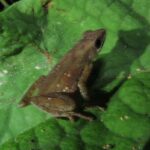- Introduction: Meet Ischnocnema lactea, the Forest Specter
- Taxonomy and Classification
- The Atlantic Forest: Natural Habitat of Ischnocnema lactea
- Physical Characteristics: Adaptations Shaped by Evolution
- Life Cycle and Remarkable Behavior
- The Vital Ecological Role of Ischnocnema lactea
- Threats and Conservation Status
- Cultural Connection and Scientific Potential: Embracing a Little-known Species
- Conclusion: Preserving the Hidden Treasures of the Atlantic Forest
Introduction: Meet Ischnocnema lactea, the Forest Specter#
In the mist-veiled heart of Brazil’s Atlantic Forest, beneath lush canopies and amidst tangled roots, lives a secretive creature known by few but cherished by ecologists and wildlife enthusiasts alike—the enchanting frog species Ischnocnema lactea. Small, elusive, and brilliantly adapted, this amphibian symbolizes the subtle wonders and delicate balance inherent in one of Earth’s richest ecosystems.
Named scientifically as Ischnocnema lactea, this member of the Brachycephalidae family exemplifies evolutionary refinement. Often overlooked due to its diminutive size and cryptic coloration, this frog stands as a vibrant reminder of nature’s incredible adaptations and imperilled diversity. Despite its humble appearance, the nuanced existence of I. lactea reveals stories of survival, adaptation, and ecological interconnectedness worthy of deep exploration and appreciation.
Let’s journey through the shaded forest floors and discover the captivating life, ecology, and conservation challenges faced by I. lactea, bringing deserved attention to this hidden gem of South American biodiversity.
Taxonomy and Classification#
The lineage of Ischnocnema lactea places it firmly within the family Brachycephalidae, a fascinating group known for their terrestrial habits and absence of aquatic tadpole stages, exhibiting direct development from eggs into miniature forms of adult frogs. First described scientifically by Miranda-Ribeiro in 1923, the species originally bore the name Eleutherodactylus lacteus, later revised into the present genus, Ischnocnema.
This genus itself is diverse and comprises numerous species primarily distinguished by molecular genetics and subtle morphological traits, highlighting the evolutionary complexity and biodiversity in Brazil’s Atlantic Forest. Closely related species include Ischnocnema guentheri and Ischnocnema parva, each demonstrating the remarkable adaptive radiation of frogs specialized to tropical forest habitats.
The Atlantic Forest: Natural Habitat of Ischnocnema lactea#
To truly appreciate the life of Ischnocnema lactea, one must venture into its homeland—the Brazilian Atlantic Forest. Spanning Brazil’s southeastern coastal mountains and densely vegetated lowlands, this biome is renowned globally for its extraordinary biodiversity proportionate to area size, hosting thousands of endemic plant and animal species.
Within this mosaic of shade and dappled sunlight, humidity blankets the understory in a persistent, nurturing embrace vital for amphibians like I. lactea. It favors damp leaf litter, fallen logs, and moss-covered stones, selecting microhabitats of consistent moisture—crucial elements for skin respiration and reproductive success. Unlike many frogs whose lifecycles demand proximity to bodies of water, this species thrives entirely on land, demonstrating remarkable adaptability to its environment.
This terrestrial habitat preference links intimately with its behavior and morphophysiology, exemplifying nature’s capability to sculpt organisms perfectly attuned to their surroundings.
Physical Characteristics: Adaptations Shaped by Evolution#
Ischnocnema lactea presents an understated and elegant beauty reflected in its subtle coloring and intricate bodily markings. Adults rarely exceed three centimeters, yet within their small frame lies impressive sophistication. Their skin is delicately textured, varying from slightly granular to smooth, adorned in varying shades of brown, beige, and cream tones that mimic decaying leaves—a perfect camouflage rendering them practically invisible on forest floors.
One noticeable characteristic is their pale coloration undersides—an adaptive trait providing minimal visibility from predators upwards from underneath. Its modestly elongated limbs and sensitive fingers allow graceful movement through leaf litter, deftly negotiating obstacles with ease. Eyes large relative to head size suggest strong nocturnal visual capability, aiding in their nighttime explorations and hunting behaviors.
In addition, their skin possesses sensitive moisture-retentive properties vital in maintaining internal hydration levels—a common evolutionary accomplishment among terrestrial amphibians confronting desiccation risks within tropical forests.
Life Cycle and Remarkable Behavior#
Direct Development: The Unique Strategy of Land-dwelling Frogs#
Perhaps the most remarkable aspect of Ischnocnema lactea‘s biology lies in its life cycle. Most frogs spend early life as aquatic tadpoles, yet I. lactea, like its close relatives in the family Brachycephalidae, exhibits a process known as “direct development.” The eggs laid directly in damp leaf litter undergo complete metamorphosis without aquatic tadpole stages, emerging as fully formed miniature versions of their parents.
This fascinating adaptation removes dependence on ponds or streams—often unpredictable in tropical forests—and grants a reproductive advantage in stability and predictability as its offspring mature safely within the leaf litter’s humid microclimate.
Nocturnal Predators: Masters of Stealth in a Competitive World#
Under the shroud of darkness, I. lactea embarks on silent hunts, preying upon termites, ants, beetles, and other invertebrates that traverse the leaf litter. Its understated coloration and stealth allow efficient predation, contributing to its ecological niche of managing insect populations within forest habitats.
In breeding season, male frogs convey subtle yet distinct mating calls—insect-like buzzes or gentle clicks—rather than loud choruses characteristic of aquatic frogs. Their discretely audible serenades help them attract mates nearby while minimizing predation risk from birds, snakes, and mammals prowling nearby.
The Vital Ecological Role of Ischnocnema lactea#
This inconspicuous amphibian serves as both predator and essential prey species, fostering ecological interactions critical to the stability of its ecosystem. Its diet of insects regulates local invertebrate populations, indirectly sustaining plant communities by controlling herbivorous insect numbers. Conversely, as prey species, small snakes, birds, mammals, and even larger amphibians depend upon frogs like I. lactea for nourishment.
Moreover, amphibians like I. lactea are sensitive bioindicators, serving as barometers for environmental health. Their permeable skins rapidly absorb environmental toxins and pollutants, making them among the first species to exhibit distress from ecological damage. Monitoring population trends helps conservationists detect ecological disturbances early, facilitating timely environmental interventions.
Threats and Conservation Status#
Sadly, the adaptable nature of I. lactea does not exempt it from vulnerability. The Atlantic Forest, despite being among Earth’s most biodiverse spots, suffers from severe deforestation, urban expansion, agriculture, and habitat fragmentation. Less than ten percent of original forest remains intact, placing enormous pressures on wildlife communities adapted to an intact, contiguous environment.
While I. lactea is classified currently as “Least Concern” on the IUCN Red List due to its relatively wide distribution within Brazil and presumed abundant populations, experts warn against complacency. Continued degeneration, fragmentation, and pollution pose significant long-term threats, emphasizing urgent actions to safeguard surviving intact forests and promote restoration efforts crucial for amphibian survival.
Cultural Connection and Scientific Potential: Embracing a Little-known Species#
Though lesser-known publicly, amphibians like I. lactea frequently inspire indigenous storytelling and traditional medicinal practices across the Atlantic forest region. However, contemporary science also recognizes their immense biological significance—potential secrets ranging from medicine to biomimetics hidden within their uniquely adapted physiologies.
The genetic, ecological, and physiological insights contained in these frogs could contribute to medical breakthroughs, environmental learning, and biodiversity conservation strategies—underscoring why safeguarding such modest creatures applies universally beneficial principles of environmental care.
Conclusion: Preserving the Hidden Treasures of the Atlantic Forest#
Ischnocnema lactea symbolizes both wonder and the precarious nature of forest biodiversity. This unobtrusive amphibian silently teaches the valuable lessons of balance and interconnectedness, eloquently reminding humanity of its responsibility toward protecting and understanding Earth’s diverse species.
By embracing curiosity, furthering conservation education, and supporting sustainable management of Brazil’s Atlantic Forest, we safeguard this exquisite species alongside countless other vital organisms sharing its ecosystem—ensuring future generations partake in nature’s unparalleled marvels hidden within the world’s treasured rainforests.







